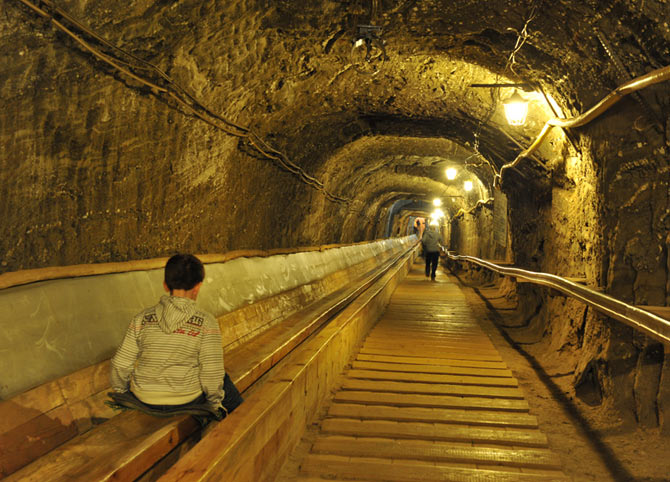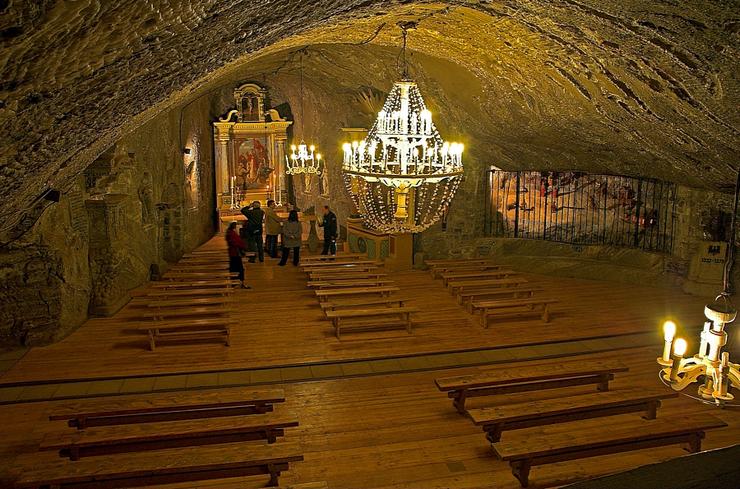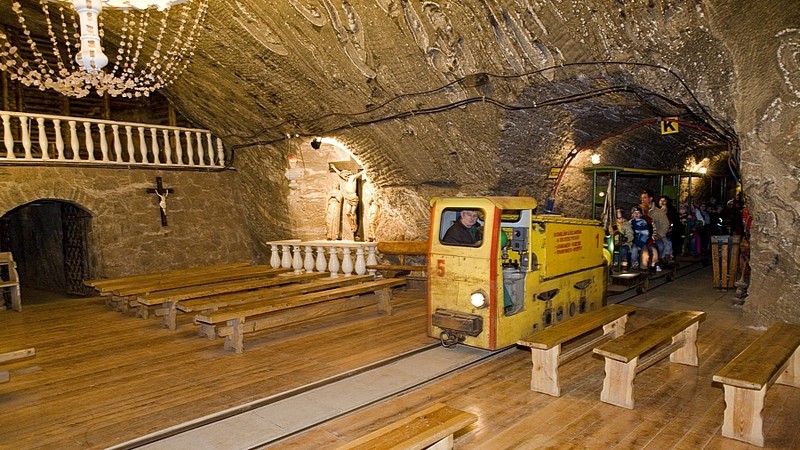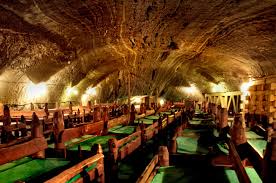|
|
Post by Bonobo on Mar 26, 2008 22:46:36 GMT 1
|
|
|
|
Post by franciszek on Mar 26, 2008 23:32:36 GMT 1
The most known is in Wieliczka near Kraków. oNe of the oldest and biggest in Europe, still active and open for tourism. These photos are just like the Tv programme amazing! just trying your" how to" guide as well.Its a very good place here! |
|
|
|
Post by Bonobo on Mar 27, 2008 10:40:34 GMT 1
Another salt mine, not as popular, though, is in Bochnia, not far from Wieliczka.
The oldest salt mine in Poland (it started to work in 1251). Not so famous like salt mine in Wieliczka (UNESCO site), but also very interesting (and not so crowded by tourists). Today it's already not working. There are museum (touristic route), health resort, sports field, some small shops and restaurant for tourists. All of it - about 200 m. under ground. On this photo - the chapel of St. Kinga, inside the mine. All sculptures and walls are made from salt.See some pics and read about it www.silentwall.com/BochniaI.html       Both mines on this site www.surprisinglypoland.pl/one_day/bochnia_wieliczka.phpComing back to Wieliczka, click and slide to the right picasaweb.google.com/absolutejewel/Poland_1013June2007/photo#5134944869134285682 |
|
|
|
Post by Bonobo on Oct 14, 2008 20:45:10 GMT 1
Salt mine in Wieliczka threatened with flood?
thenews.pl
10.10.2008
The risk of a major flood in the historic salt mine in Wieliczka,
southern Poland, has drastically increased, some geophysics
specialists claim, due to errors by the mine's management.
The chief geologist at Wieliczka - a popular tourist attraction
near Krakow - claims that the mine is safe and protected by a
special dam from water which naturally seeps into the shafts, though an expert at the AGH University of Science and Technology disagrees.
The dam protecting the mine against flooding is a concrete block,
six metres thick, equipped with pressure measuring instruments which control the flow of water through a system of valves. Normally the valves allow for a controlled flow of water, though as the volume of water has increased the dam has been completely closed down.
The mine's chief geologist Krzysztof Brudnik told Polish Radio that
thanks to completely cutting the flow of water, the mine and the
town above it are safe.
According to Antoni Lopata, Ph.D. of the AGH University of Science
and Technology, however, the pressure of water behind the dam
threatens to cause a catastrophe collapse of the mine.
This is not the first time the salt mine has experienced similar
risks. In 1992 the water forced its way into the mine, stopping salt
mining as the land was shook and walls of surrounding houses
cracked.
The Wieliczka Salt Mine is one of the world's oldest salt mines. In
1978 it was placed on the UNESCO World Heritage List.
|
|
|
|
Post by Bonobo on Jan 19, 2011 22:07:59 GMT 1
Wieliczka Salt Mine hits tourist record
01.01.2011 11:25
The number of visitors to the historic salt mine in Wieliczka near Kraków has topped the one million mark.
On the penultimate day of 2010, Ms Urszula Szczęsnowicz, who came to the site with her family from Mława, north of Warsaw, was greeted as the one millionth visitor by the Director of the Salt Mine Kajetan d'Obyr.
She was given a red-carpet treatment, taken on a special tour of the place, presented with gifts and asked to put her signature in the Visitors Book, alongside such celebrities as Fryderyk Chopin, Duke Edward Windsor and the King of the Belgians Albert II.
2010 saw a three percent increase in the number of visitors to Wieliczka. Foreigners account for 52 percent of visitors. The British top the list (56.900), followed by Germans (39.300), Italians (36. 500), French (32.500) and Koreans (31. 600).
The Wieliczka Salt Mine was founded in the middle of the 13th century. It features a 3.5-km touring route for visitors that includes historic statues and mythical figures. There are also a large chapel, an underground lake, as well as a private rehabilitation and wellness complex.
In 1978 the Wieliczka Mine was included in the original UNESCO list of World Heritage Sites.
|
|
|
|
Post by valpomike on Jan 20, 2011 0:28:09 GMT 1
I have been in them, and yes, it is something to see.
Mike
|
|
|
|
Post by Bonobo on Apr 24, 2011 16:47:20 GMT 1
|
|
|
|
Post by Bonobo on Nov 27, 2011 20:46:25 GMT 1
Wieliczka Salt Mine gets one million visitors this year
24.11.2011 09:52
The number of visitors to the historic salt mine in Wieliczka near Kraków has topped the one million mark this year.
The one millionth visitor was Ma³gorzata Kawiñska, a Pole who moved to the Netherlands ten years ago and who is now touring her homeland with a friend.
She was given a red-carpet treatment, including a gift of a set of souvenirs, sculptures and cosmetics – all made of salt. She was also asked to put her signature in the Visitors Book, alongside such celebrities as Fryderyk Chopin, Duke Edward Windsor and the King of the Belgians Albert II.
Last year, the one millionth visitors came to Wieliczka on 30 December, an evident sign of the fast-growing popularity of the place. As in previous years, this year, too, the British top the list of foreign visitors (48.5 thousand), followed by Germans (35.2 thousand), Italians (33.9 thousand), French and Koreans. Since 1945 the mine has attracted 36 million tourists.
The Wieliczka Salt Mine was founded in the middle of the 13th century. It features a 3.5-km touring route for visitors that includes historic statues and mythical figures. There are also a large chapel, an underground lake, as well as a private rehabilitation and wellness complex.
In 1978 the mine was included in the original UNESCO list of World Heritage Sites.
|
|
|
|
Post by Bonobo on Jan 24, 2013 20:06:58 GMT 1
|
|
|
|
Post by Bonobo on Jan 15, 2017 12:49:43 GMT 1
|
|